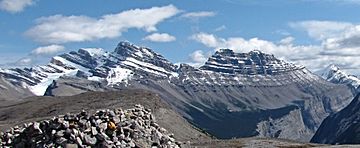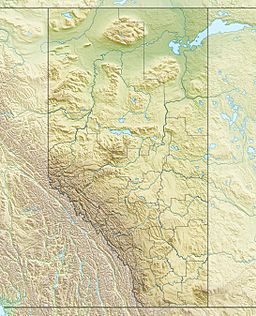Cirrus Mountain facts for kids
Cirrus Mountain is a tall mountain in the Canadian Rockies of Alberta, Canada. It stands 3,270-metre (10,730-foot) high. You can find it in the upper North Saskatchewan River valley. It sits right on the edge of Banff National Park and the White Goat Wilderness Area.
Cirrus Mountain is located along the east side of the famous Icefields Parkway. It's about halfway between Saskatchewan Crossing and Sunwapta Pass. The closest higher mountain is Mount Stewart, which is about 5.92 km (3.68 mi) to the north.
Quick facts for kids Cirrus Mountain |
|
|---|---|

Cirrus Mountain with summit to left. Viewed from Parker Ridge
|
|
| Highest point | |
| Elevation | 3,270 m (10,730 ft) |
| Prominence | 890 m (2,920 ft) |
| Parent peak | Mount Stewart (3312 m) |
| Listing | Mountains of Alberta |
| Geography | |
| Location | Alberta, Canada |
| Parent range | Canadian Rockies |
| Topo map | NTS 83C/02 |
| Type of rock | Sedimentary |
| Climbing | |
| First ascent | 1939 by C.B. Sissons, H.J. Sissons |
| Easiest route | technical climb |
Contents
Mountain's Name and First Climb
In 1928, someone suggested naming the mountain Mount Huntington. However, this name was not chosen for the mountain itself. The name Huntington is still used for the large glacier found on the east side of the mountain.
The mountain was officially named Cirrus Mountain in 1935. The first people to successfully climb Cirrus Mountain were C.B. Sissons and H.J. Sissons. They reached the top in 1939.
What Cirrus Mountain is Made Of
Just like other mountains in Banff National Park, Cirrus Mountain is made of sedimentary rock. This type of rock formed over millions of years from tiny bits of sand and mud settling in ancient shallow seas.
These layers of rock were later pushed up and folded during a huge mountain-building event called the Laramide orogeny. The eastern side of Cirrus Mountain is covered by a large sheet of ice called the Huntington Glacier.
Weather and Climate Around Cirrus Mountain
Cirrus Mountain has a subarctic climate. This means it has very cold and snowy winters. The summers are usually mild. Temperatures can drop below -20 °C. With the wind, it can feel even colder, sometimes below -30 °C.
The cold winter weather creates amazing ice formations on the mountain. One famous spot is the Weeping Wall. It's located at the base of Cirrus Mountain's west face. This area is a top spot for ice climbing in the Canadian Rockies.
All the water from rain and melting snow on Cirrus Mountain flows into small streams. These streams eventually join the North Saskatchewan River.
Popular Ice Climbing Routes
Cirrus Mountain is famous for its challenging ice climbing routes. Here are some of the well-known routes, along with their difficulty ratings:
- Polar Circus - WI5
- Snivelling Gully - WI3
- Weeping Wall - WI3-6
- Weeping Pillar - WI6
Gallery






